YOUR NO 1 WOODWORKING POWER TOOLS RESOURCE WEBSITE
7 Workshop Safety Gears You Should Use As a Woodworker (Practical Options)
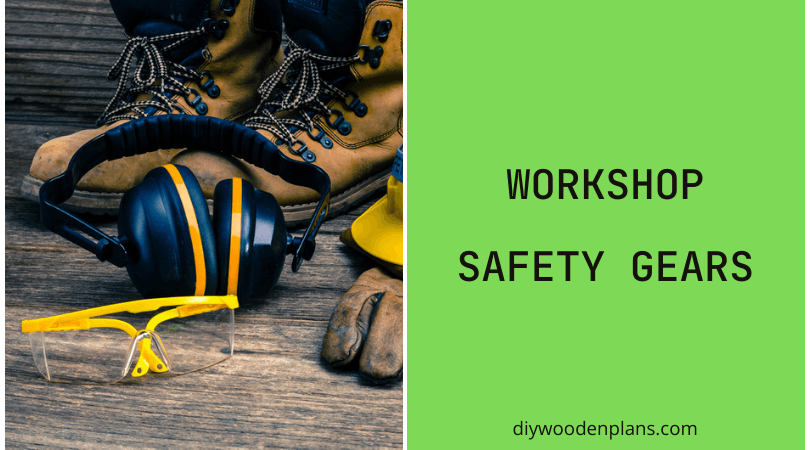
Disclosure: If you click on some of the links, we may earn a small referral fee. Please know that we only recommend products that we use and believe will add value to our readers.
It may surprise you to know that a large number of woodworkers get injured annually while working in their workshops.
The problem is that woodworkers with loads of experience tend to think they don’t need safety equipment, while woodworking newbies don’t realize the importance of using workshop safety gears.
It doesn’t matter your experience level, if you don’t protect yourself and use the right safety gear while woodworking, you will pay the price!
I have drafted this article to serve as your workshop safety equipment checklist. Feel free to bookmark it and make reference to it as you go.
Related Articles: 8 Power Tool Storage Systems to Keep Your Workshop Safe and Organized
Essential Woodworking Safety Equipment
There are different categories of woodworking safety equipment, each one of which serves a unique purpose. While some are used for personal protection, others are needed for the safety of the workshop and workspace.
1. Personal Protective Equipment (PPE)
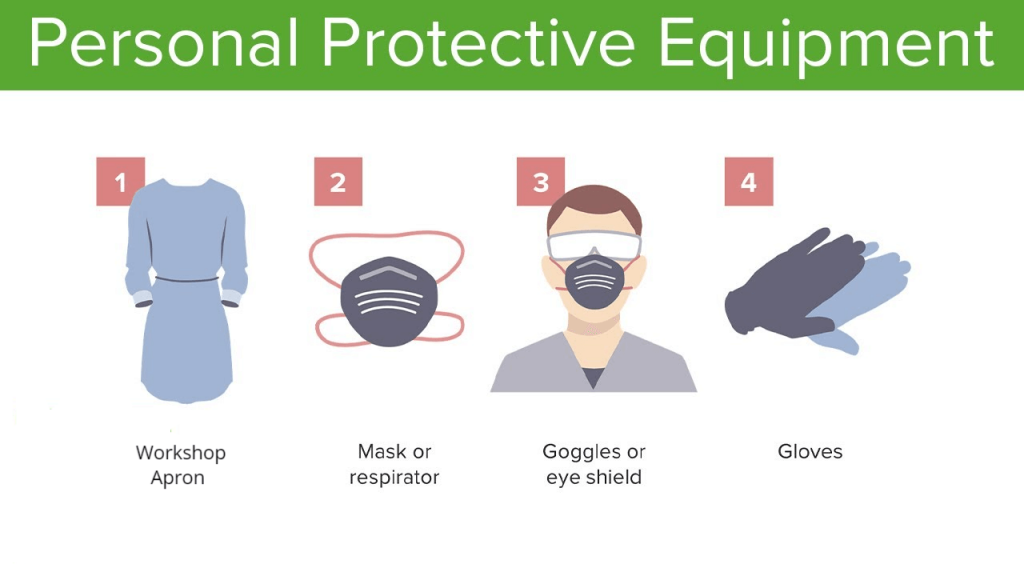
The Lack of proper personal protective equipment (also known as PPE) accounts for 80% of workshop injuries.
You shouldn’t dream of picking up any woodworking tool without properly kitting up for the task. This advice might sound a little bit mundane, but trust me, it will do you a whole lot of good.
Below are the most important parts of your body you should protect and their corresponding PPE.
A. Body Protection: Workshop Coveralls
When working with power tools and other woodworking heavy machinery, you should pay special attention to your clothing. Loose-fitting clothes, flared sleeves, or short clothes can be extremely hazardous as they can get entangled with tools and machinery.
You should always wear a coverall while woodworking. Wearing a coverall will not only keep you safe, it will keep your clothes clean.
There are different designs of coveralls to choose from. My personal recommendation would be to:
- Choose ones that fit you perfectly and are comfortable to wear.
- Buy the ones with more pockets, as this makes it easy to keep small tools close by.
Get workshop coveralls available at:
B. Eye Protection: Safety Glasses, Goggles, or Face Shields
Safety goggles or safety glasses are one of the most important pieces of safety equipment for woodworkers. When working, you use your eyes to focus on what you are doing, which is why your eyes are usually the closest to all the hazardous tools and items.
Leaving your eyes exposed and uncovered can lead to various accidents that can damage your eyes. Some of the most common dangers include splinters of wood, sawdust or even sharp tools getting into your eyes. Therefore, you should always keep your safety goggles on when you are woodworking.
When buying a safety goggle, make sure they have shatterproof polycarbonate lenses, confortable to wear, and can be adjusted to fit you perfectly
Generally, safety goggles or glasses should be worn when carrying out light work, while face shields are required when doing hazardous work.
Get safety glasses/goggle/face shields available at:
C. Hearing Protection: Ear Muffs, Foam Plugs or Ear Inserts
Many woodworkers tend to take ear protection lightly, often ignoring the importance of ear muffs. Woodworking machinery and power tools are very loud, and being regularly exposed to these loud noises can cause serious damage to your ears
Instead of waiting for loud machines to damage your ears gradually, make sure to use ear muffs or foam plugs!
Ear muffs offer the best hearing protection, followed by expandable foam plugs and corded ear inserts.
Get ear muffs/foam plugs/ear inserts available at:
D. Lung Protection: Respirators or Dust Masks
The release of fine dust is unavoidable in a woodworking workshop. The various machines and tools used generate a lot of dust. Constant exposure to this dust can affect your health in the long run.
From irritating your lungs to causing respiratory issues, the dust produced in woodworking workshops can be a huge health hazard. It is best to always wear a dust mask so that the dangerous dust and fumes are prevented from entering your respiratory system.
There are three (3) types of masks that are used in a woodworking shop and they all have their specific usage:
- A particle or disposable mask should be worn when doing general shop work.
- A dust mask is needed when there are fine particles, like sawdust and insulation fibers. A dust mask with replaceable filters and a flexible faceplate is usually preffered.
- Finally, a respirator is used to protect against fumes and very fine particles, especially when working with chemicals. They are usually fitted with filters and cartridges.
Get ear respirators and dust masks available at:
E. Hand Protection: Cut Resistant Hand Gloves
When woodworking, you usually work with blades, saws, power tools, and many other dangerous equipment that can hurt your hands. If you leave your hands unprotected and uncovered, the chances of getting cuts become much higher than when you wear a protective glove.
Therefore, it is best to always wear cut-resistant hand gloves when working with your tools in a woodworking workshop.
Get cut resistant hand gloves available at:
F. Feet Protection: Safety Boots
Yes, even your feet need protection when woodworking in the workshop. Most woodworkers do not take foot protection seriously, which often leads to serious foot injuries and accidents.
Some of the most common woodworking foot injuries include dropping heavy items on the foot or stepping on sharp objects. Both of these injuries, and many more, can be prevented by wearing safety boots while working.
Invest in a pair of safety boots today and protect your feet while working in the workshop.
Get safety boots available at:
2. Push Sticks and Blocks

When using table saws, wood shapers, band saws, routers and other similar tools with blades, you don’t want to be using your fingers directly. To ensure your safety, your hand need to be far away from the cutters and blades
That’s the reason why using push sticks and blocks is always recommended. These sticks and blocks allow you to control and move the wood closer to the cutter without having to risk your fingers.
Get push blocks available at:
3. First Aid Kit

Despite all the precautions and safety measures, accidents do happen. Make sure to always keep a well-maintained first aid box within the premises of your woodworking workshop.
A well-equiped workshop first aid kit should contain (as a minimum):
- Plenty of gauze and bandages
- Antiseptic first aid ointment
- Latex gloves
- A cold compress
- Rub alcohol swabs
- A disinfectant such as iodine
- and a first aid guide book.
Get first aid kits available at:
4. Fire Extinguisher
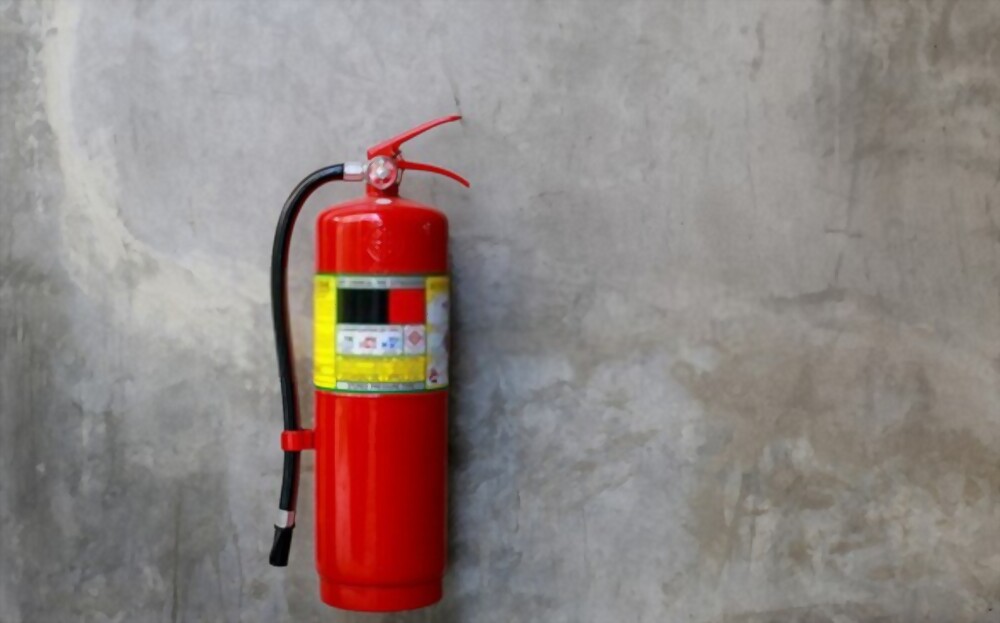
Fire outbreaks are highly likely in a woodworking shop since wood is the major raw product and it is highly flammable.
Also, apart from wood, there are other materials in the workshop that are flammable and can cause fire if not handled properly.
Therefore, you should always be prepared! Make sure to always have an updated, fully-functional, and easy-to-use fire extinguisher present in your workshop at all times.
Fire extinguishers are rated by their ability to combat fires of varying causes:
- A fire extinguisher rated “A” is effective against trash wood and paper fires.
- “B” will extinguish flammable liquids and grease fires.
- “C” can be used for electrical fires.
For a woodworking shop, you should buy a dry chemical fire extinguisher with an “ABC” rating.
Get fire extinguishers available at:
5. Safety Power Tool Switch
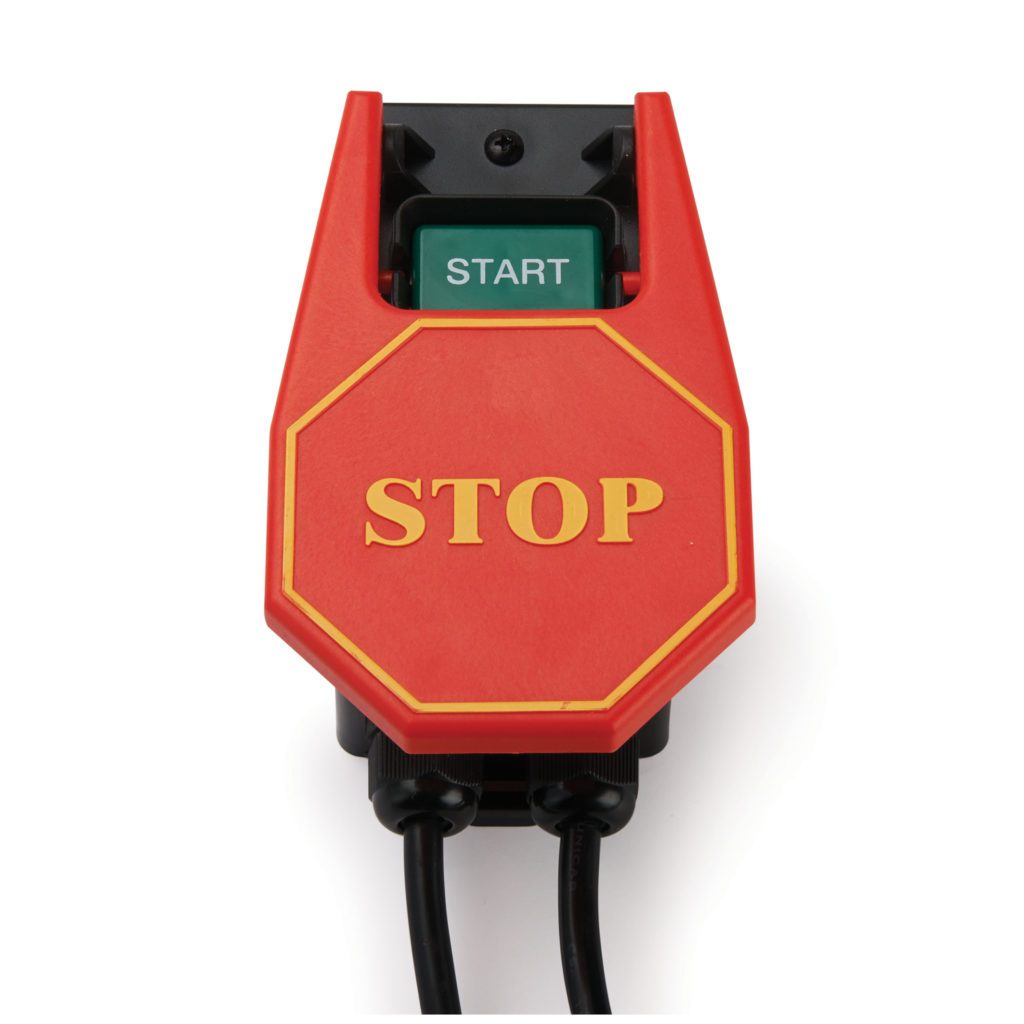
There are many power tools used in a woodworking workshop that do not have an easy to operate or accessible power switch. As a result, the shutting down process of such tools is difficult.
Therefore, it is best to get a safety power tool switch. This switch gives you an accessible button that shuts down benchtop power tools easily.
Here is a detailed article on how to install a safety power tool switch
6. Cyclone Dust Collection System
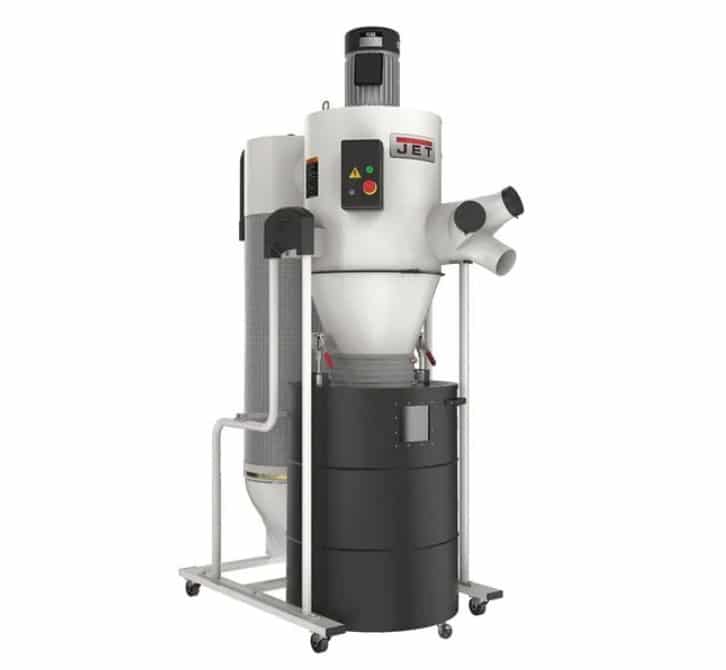
Sometimes dust masks and respirators aren’t just enough. You may need something more robust to collect the tiniest of fine dust generated in your workshop. This is where a woodworking dust collector comes in.
Dust collectors prevent the spreading and lingering of fine dust particles that may not be caught by a simple dust mask.
For maximum efficiency I would recommend you install a cyclone dust collection system in your workshop.
Here is a complete article: Cyclone Woodworking Dust Collection Systems (Your Ultimate Guide + FAQs)
7. Create an Emergency Area
Technically, this is not a gear, but it is absolutely necessary.
The workshop is perhaps the most accident-prone area of your home. Sharp blades, heavy objects, dangerous chemicals, and flammable materials are just a few of the factors that increase accidents in the workshop.
While good housekeeping, respect for your tools, and common sense will go a long way towards reducing the risk of accidents, you should still be prepared in the event that an accident occurs.
Designate a part of your workshop as an emergency center and equip it with a fully stocked first aid kit, a fire extinguisher, and a telephone with emergency numbers clearly posted on it.
Related Article: 15 Safety Precautions To Take When Using Power Tools
Conclusion
Now that you know what workshop safety gears you must have, always keep these items well-maintained and close at hand. It is best to use the proper safety equipment to begin a woodworking project as soon as possible so that you can develop the habit.
Also, ensure that the equipment you purchase is durable, so you can continue using it for an extended period without it suffering from wear and tear.
Adding to this, here is another article you should read: 9 Must-Have Woodworking Power Tools For Your Workshop.
Pinterest Image
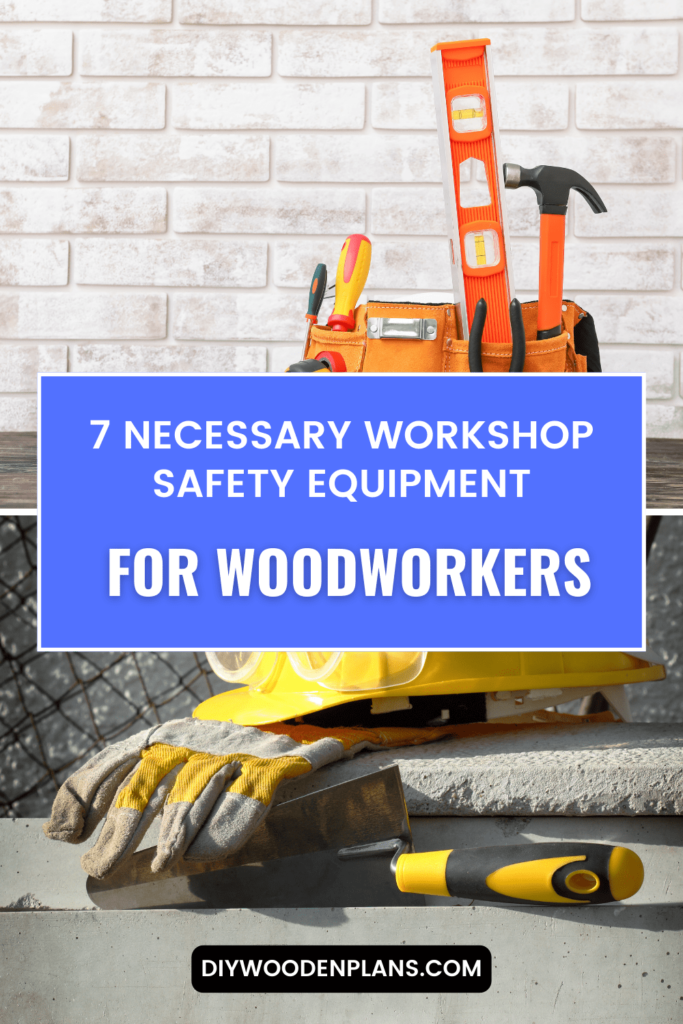
Enjoy our articles? You can follow us on Pinterest for more woodworking power tools tips and tricks.
Save on selected power tools from top brands - Shop Now on Zoro.



